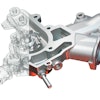If you are replacing your ERP system because it doesn't do X, let me pose a question to you. What about Y? What is Y? Y is that thing you will need your ERP to do tomorrow, but don't know about today. Y is your next X.
Even if operational performance is deteriorating, companies tend to accept the status quo of their ERP system until performance has deteriorated to the point where they can no longer bear it. This is the point where they decide that they need a new solution and enter another ERP selection cycle. It doesn’t have to be like this. A continuous improvement approach — like those used in other parts of your business — can be applied to your business processes and supporting systems. While no one knows what the future will look like in five years, we do know that it will be different from today. The only constant is change. In such an environment, agility trumps the best-laid plans.
Toward a Continuous Improvement Approach
The rigid nature of ERP stems from attitudes on both the ERP vendor side and the customer side. Customer often follow feature checklists instead of focusing on how well a solution will meet their long term business requirements. Most vendors focus on license sales and now bookings rather than on the mutual value of the solution and the relationship over the long term. The software, services and customer engagement strategies of traditional ERP vendors often reflect this focus.
In an ever changing world, continuous improvement is a fundamental requirement for maintaining fit for the long term between your business strategy, the people, process and best practices you utilize to apply that strategy and the technology that supports it. The design of your ERP implementation is less important than the ability of your ERP solution to respond to change.
Periodic Review
ERP success should not be defined by the “Go Live” of your ERP implementation. While it is an important milestone, “Go Live” marks only the end of the beginning phase of your ERP life cycle. The same type of efforts that went into your solution design should be applied on a yearly bases to your emerging business challenges.
Ask yourself “what has changed in your business environment? How can your business processes adapt to meet those changes? How can your ERP system best support these new business processes?” A structured approach that leverages key internal stakeholders and your ERP vendor helps to ensure that gaps are minimized and best practices are applied.
This structured approach starts with a deep discovery process that allows a company to identify its current business goals and challenges, and to determine the root causes of these challenges.
A thorough examination of high-level processes can steer the initial discussion. Through discovery, specific processes and review areas unique to the situation can be examined in greater detail.
The intent is to examine the current processes, be open-minded and determine how well those current processes meet the current needs. The operational effectiveness of a company is not found in its ERP system but in the business processes, which are supported by the ERP.
KPIs as Diagnostics
Performance should be evaluated against desired outcomes. A KPI framework that links process, skills, and the best practices that impact these KPI is a powerful tool. It is very likely that the source of performance issues exists outside of or in addition to the technology. Often it is about alignment. The KPI framework acts both as a diagnostic tool and as a roadmap for addressing your business challenges. It can provide an early warning of future problems.
Executed correctly, these efforts will produce a series of alternatives that can drive meaningful improvement in focus metrics by improving business processes and supporting them with a rational set of software. Often the process identifies how to use current assets better — without the need for new software or services.
Assessments
Where alternatives generate significant interest, deeper dive assessments should be pursued to further validate and quantify the potential value.
These assessments can be both diagnostic and prescriptive. Example Assessments can include:
- Compliance - aimed to help ensure compliance with industry standards
- KPI - to develop appropriate KPIs for your business
- Learning - to identify areas where system or process training could improve operational effectiveness
- Customization - seeking to remove system customizations to deliver a more agile system
- Process - related assessments aimed to review business processes against best practices and the unique requirements of the business
Projects
Once they are adequately researched, alternatives can turn into projects. Each project should start with a baseline measurement and conclude with an outcome measurement of the metrics the project was designed to improve. Comparing outcomes to baselines provides an assessment of the value delivered and points out areas that may need further optimization.
The ERP vendor should play an important role throughout the entire process. Because they have experience across multiple companies and industries, ERP vendors can bring best practices to the table. With a deep understanding of the technologies, trade offs can be highlighted and weighed in the decision making process. Adopting a business process without regard for the ERP or accepting a standard process in the ERP without regard for unique business needs can both lead to suboptimal outcomes. The best outcomes are found through partnership.
Staying Agile
If you find yourself in the unfortunate position of needing to select a new ERP system, make sure that agility is one of your selection criteria. While the software you choose should provide reasonable fit out-of-the-box, it should also allow you to meet your unique requirements without requiring customization, creating further rigidity or making upgrading more difficult. Agile systems allow for personalization, provide user-friendly configuration of embedded analytics, are modular, can be extended without code, and support your home grown or partner applications within the platform itself. You need an ERP partner for the long term. Ensure they share your view of continuous improvement and have programs in place to support it.
Carter Lloyds is Chief Marketing Officer at QAD.






















